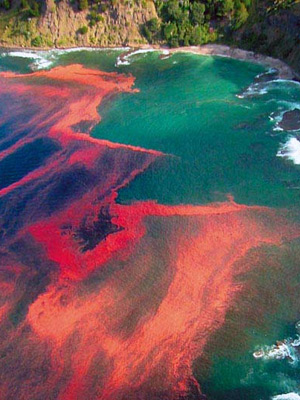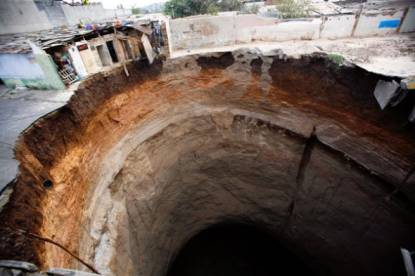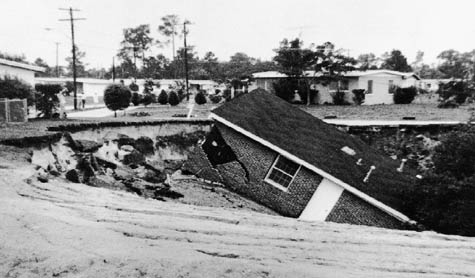Post by Deleted on Sept 24, 2011 20:46:18 GMT
Red Tides


Red tide is a common name for a phenomenon also known as an algal bloom (large concentrations of aquatic microorganisms), an event in which estuarine, marine, or fresh water algae accumulate rapidly in the water column and results in discoloration of the surface water. It is usually found in coastal areas.[1]
Penitent Ice


Penitentes, or nieves penitentes ("penitente-shaped snows", in Spanish), are a snow formation found at high altitudes. They take the form of tall thin blades of hardened snow or ice closely spaced with the blades oriented towards the general direction of the sun. Penitentes can be as tall as a person.
Columns of Light


These strange columns of light shinning from the sky in Latvia were caused by the natural phenomena of ice crystals reflecting bright light on to the ground - and not by UFOs
Blue Holes


A blue hole is a cave (inland) or underwater sinkhole. They are also called vertical caves. There are many different blue holes located around the world, typically in low-lying coastal regions. The best known examples can be found in Belize, the Bahamas, Guam, Australia (in the Great Barrier Reef), and Egypt (in the Red Sea).
Blue holes are roughly circular, steep-walled depressions, and so named for the dramatic contrast between the dark blue, deep waters of their depths and the lighter blue of the shallows around them.
Columnar Basalt


Columnar jointed volcanics exists on many places on earth. Perhaps the most famous basalt flow in the world is the Giant's Causeway on the northern coast of Ireland, in which the vertical joints form polygonal columns and give the impression of having been artificially constructed
Circles of Ice

An ice disc, ice circle, or ice pan is a natural phenomenon that occurs in slow moving water in cold climates. Ice circles are thin and circular slabs of ice that rotate slowly in the water. It is believed that they form in eddy currents. Ice discs have most frequently been observed in Scandinavia and North America, but they are occasionally recorded as far south as England and Wales. An ice disc was observed in Wales in December 2008 and another was reported in England in January 2009.[1][2][3]
Ice circles vary in size but have been reported to be more than 4 metres (13 ft) in diameter
Sink Holes



A sinkhole, also known as a sink, shake hole, swallow hole, swallet, doline or cenote, is a natural depression or hole in the Earth's surface caused by karst processes — the chemical dissolution of carbonate rocks[1] or suffosion processes[2] for example in sandstone. Sinkholes may vary in size from 1 to 600 meters (3.3 to 2,000 ft) both in diameter and depth, and vary in form from soil-lined bowls to bedrock-edged chasms. Sinkholes may be formed gradually or suddenly, and are found worldwide. The different terms for sinkholes are often used interchangeably
* the info is from wiki*
love suzy


Red tide is a common name for a phenomenon also known as an algal bloom (large concentrations of aquatic microorganisms), an event in which estuarine, marine, or fresh water algae accumulate rapidly in the water column and results in discoloration of the surface water. It is usually found in coastal areas.[1]
Penitent Ice


Penitentes, or nieves penitentes ("penitente-shaped snows", in Spanish), are a snow formation found at high altitudes. They take the form of tall thin blades of hardened snow or ice closely spaced with the blades oriented towards the general direction of the sun. Penitentes can be as tall as a person.
Columns of Light


These strange columns of light shinning from the sky in Latvia were caused by the natural phenomena of ice crystals reflecting bright light on to the ground - and not by UFOs
Blue Holes


A blue hole is a cave (inland) or underwater sinkhole. They are also called vertical caves. There are many different blue holes located around the world, typically in low-lying coastal regions. The best known examples can be found in Belize, the Bahamas, Guam, Australia (in the Great Barrier Reef), and Egypt (in the Red Sea).
Blue holes are roughly circular, steep-walled depressions, and so named for the dramatic contrast between the dark blue, deep waters of their depths and the lighter blue of the shallows around them.
Columnar Basalt


Columnar jointed volcanics exists on many places on earth. Perhaps the most famous basalt flow in the world is the Giant's Causeway on the northern coast of Ireland, in which the vertical joints form polygonal columns and give the impression of having been artificially constructed
Circles of Ice

An ice disc, ice circle, or ice pan is a natural phenomenon that occurs in slow moving water in cold climates. Ice circles are thin and circular slabs of ice that rotate slowly in the water. It is believed that they form in eddy currents. Ice discs have most frequently been observed in Scandinavia and North America, but they are occasionally recorded as far south as England and Wales. An ice disc was observed in Wales in December 2008 and another was reported in England in January 2009.[1][2][3]
Ice circles vary in size but have been reported to be more than 4 metres (13 ft) in diameter
Sink Holes



A sinkhole, also known as a sink, shake hole, swallow hole, swallet, doline or cenote, is a natural depression or hole in the Earth's surface caused by karst processes — the chemical dissolution of carbonate rocks[1] or suffosion processes[2] for example in sandstone. Sinkholes may vary in size from 1 to 600 meters (3.3 to 2,000 ft) both in diameter and depth, and vary in form from soil-lined bowls to bedrock-edged chasms. Sinkholes may be formed gradually or suddenly, and are found worldwide. The different terms for sinkholes are often used interchangeably
* the info is from wiki*
love suzy
